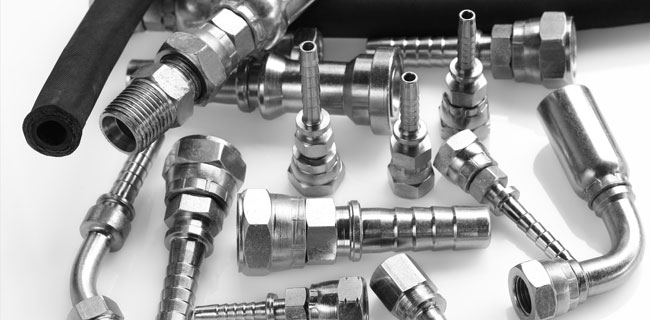Hydraulic hoses are used in many different industrial applications and the kind of hydraulic hose can vary depending on the task at hand. Types of hydraulic hose can include reinforced, coiled, corrugated or convoluted and can be made from various materials such as elastomers, fluoropolymers, silicone, thermoplastics and metal. Choosing the right hydraulic hose can be complicated enough, when factoring in materials, applications and pressure ratings. Choosing the right hydraulic fittings that get the job done and can stand the test of time safely is another matter entirely.
Once you decide on the hydraulic hose that will be used, the next step is to create a reliable and leak-free connection. Unfortunately, that’s easier said than done. OEMs and fitting manufacturers are always developing new fittings with new threads and new seal techniques and often fail to let end-users in on the secrets. What worked the last time doesn’t always pan out, leaving us scratching our heads wondering why this brand-new fitting is still leaking. Not only is this frustrating, but costly. Every time machinery or equipment is down due to a faulty hose assembly, it puts schedules behind and eats into already scant budgets.
The acronym STAMPED — Size, Temperature, Application, Media, Pressure, End and Delivery — can help you choose the right hydraulic fitting for your needs. Learn how you can use STAMPED to make fitting selection easy and effective.
7 Tips to Choosing the Right Hydraulic Hose Fittings for Your Application
1. SIZE: Consider the size of your hose and the tube’s outside diameter when choosing hose fittings. Not only does the hose’s outside diameter need to be measured, but also its wall thickness. The hydraulic hose’s inside diameter must also be taken into consideration. This helps keep pressure loss to a minimum and maintains proper flow. Correctly identifying these characteristics can then enable you to choose the hose fitting based on system pressure, flow rates and the environment the hydraulic hose is used.
2. TEMPERATURE: Consider the hydraulic hose’s average, minimum and maximum operating temperature ranges when choosing various hose fitting materials and seals like O-rings. Be sure to consider factors such as flame-resistance as well.
3. APPLICATION: Consider where and how your hydraulic hose will be used. Will it be used indoors or outdoors? Will there be excessive abrasion, vibration, unusual mechanical loads or exposure to external conditions such as moisture, salt water, fertilizer, oxygen, oil, acids or chemicals? Choose coatings and special platings for your fittings that can minimize corrosion or breakdown of the fitting.
4. MEDIA: What kind of fluid will be carried through your hydraulic hose? Special materials require specialized hose materials and fitting components that are compatible with the fluid being used. Eaton Weatherhead shares their Fluid Compatibility Chart here.
5. PRESSURE: Consider your system’s average operating pressures and its compatibility with the maximum pressures associated with your hose assembly. Static hydraulic systems are free of vibration, pressure surges and shocks. Dynamic hydraulic systems commonly experience pressure spikes. Your hose assembly’s working pressures must be equal to or greater than the system pressure itself for safety and effectiveness.
6. END: What kind of end is required to connect hoses to the system? Remember that these areas are the weakest link in your hose assembly and having this information will help you identify the proper fitting and clamping systems to use.
7. DELIVERY: Consider customer requirements, testing requirements and certification requirements as well as the packaging and shipping requirements associated with hose assembly. Once a new hose assembly has been put into service, it’s important to fully inspect regularly and look for worn out fittings, clamps or damaged hoses.
Download our STAMPED form now to get started.
If you struggle to maintain leak-free connections with your hydraulic hose assemblies, we can help. We offer custom hose assembly for multiple applications. In fact, it’s our specialty. Not sure what you need? Contact us today to discuss your needs or to schedule an onsite consultation at 314-638-6500 option 4.

